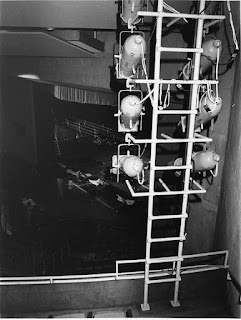At the time Power Center for the Performing Arts was less than ten years old and had state-of-the art stage equipment.
http://www.music.umich.edu/about/facilities/central_campus/power/index.htm
Power Center
With the addition of a professional actor, director or designer much more was expected from the Guest Artist Series plays.
The budget and scope of these plays were bigger and were given much more support than the showcase productions.
Soon after I graduated the Power Center went through a major renovation with the addition of a new scene shop and other added spaces.
The lighting board was an early computer controlled system that was not very sophisticated by today’s standards but still it was better than anything else I had seen in use at that time.
Reading over the new Technical Specifications I have seen that all of the lighting and sound equipment is new and up to date.
I would also work on all of the other department productions in the Power Center as an electrician, carpenter or sound engineer.
Additional I worked on several touring Broadway plays, an opera and several dance pieces.
In total I worked on almost 30 major productions plus many smaller events in one capacity or another during my two years at Michigan.
The Power Center is a large theatre and was the biggest I had worked in up until that time.
Working up in the lighting rings was always fun especially those right over that front of the stage.
To focus the lights in the closest rings to the stage you had to sit with your butt on the edge of the opening with your feet on the other side, the light between your legs and the floor 30 feet below.
This was all done without a safety harness.
Lighting Rings over the Seats
To work on the lights in the Rings over the audience you had a climb a ladder on side of the balcony up through a trap door.
There were lights on the ladder too and these were very hard to focus.
The follow spots and sound control board was also there and the technicians running the shows often brought a larger coffee can with them as there was no quick or easy access to the restrooms during a performance.
Ladder up to the Rings
The theatre had at least one union (IASTE) stage technician at all times plus a doorman.
The doorman, usually an older member of the union, checked people’s names as they came in to work.
The Senior House Tech technician kept a log book with every light and the date a new lamp was put into it and he was always mad at our teacher for using different lamps in the lights.
There were always 750 watt lamps in all of the lights and our teacher always had us add 1500 watt lamps in many of the front of house lights but always forget to change out a few after the show was over and this would always piss the Senior House Tech off.
When I designed in the theatre I would just plan to have two units side-by-side assigned to do the same job hoping that the combined output would throw enough light from the rear lighting ring to the stage.
There were a few other quirks with the theatre.
One student assigned to run the lighting board had to be replaced because he had an electrical charge to his body that would change the levels of the lights when he got near the control panel.
Just by running his hand over the board you could watch the levels go up and down on the dials and onstage.
Very unique.
They had not planned the loading dock very well as the road leading to it came up a hill and trucks had a hard time backing up it even if there was just a little ice on it.
One time while working in the theatre there was a wonderful bright shaft of light came down on the stage but the designer could not get it to turn off.
After a few minutes we all realized that a balcony door was open to the lobby and that the shaft of light was reflected sunlight bounced around the big glass lobby that way.
It only happened that one time while I was there, but it very funny watching the light board operator trying to figure out what was wrong.
There were other places that I got to work while in Michigan but I spent most of my time in the Frieze Building and the Power Center which were just a few blocks apart.




No comments:
Post a Comment